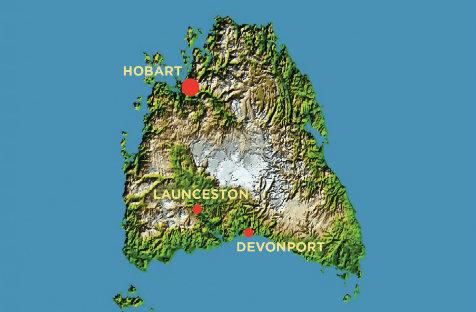Statistically, Tasmania is not faring well; levels of health, employment, education and investment are low. Too low. Tasmania’s geographical isolation has long been perceived as its downfall, yet paradoxically this factor also contributes to some of the state’s greatest virtues. The magnificent and unique landscape, and its location as the basis for Australia’s Antarctic science program, are world renowned.
Is Tasmania on the cusp of something? What that something is, or could be, is the subject of the latest issue of the GriffithREVIEW, in which founding editor Julianne Schultz, together with Natasha Cica (director of the Inglis Clark Centre for Civil Society at the University of Tasmania) thread together essays, memoirs, fiction and visual art from some of the people who know Tasmania best.
Compiled in conjunction with the University of Tasmania, the resulting volume is a collection of deconstructed myths, flowing narratives, and jarring historical truths. The truth about Tasmania is complicated.
The writers selected for this edition of the Griffith REVIEW do not shy away from strong opinions. Jonathan West, director of the Australian Innovation Research Centre, boldly states his belief that Tasmania ‘reproduces under-achievement generation after generation’, detailing several stumbling blocks preventing Tasmania from moving forward both economically and socially. Conversely Jo Chandler’s fascinating report, ‘The science laboratory’, puts Tasmanian scientists at the forefront of their field, boasting: ‘Hobart voices will be at the heart of the maelstrom.’ Writer Fleur Fallon echoes this optimism; reflecting on Tasmania’s unique mix of ‘resilience’ and ‘vulnerable fragility’ she concedes ‘There is something remarkable going on here at the Edge of the World’.
Greg Lehman (Australian Institute of Aboriginal and Torres Strait Islander Studies), writes from a stereotypically romantic setting in a French attic hideaway nestled ‘in a small, crooked, medieval building’ in the heart of Alsace. The vision created belies the more sombre reason for his journey to Europe. Lehman provides an intriguing exploration for the historical context of what memoir writer Margaret Merrilees describes as ‘a story so ugly that it was generations before the survivors could even be allowed to tell it’. The Black War, 1828-1864. Lehman describes this haunting element of Tasmania’s history as the ‘tip of the iceberg of human conflict’. He discovers it to be entrenched within the European foundations of ‘an eternity of war’. Lehman’s sharp-minded writing is no less forgiving in light of this realisation; the injustices of ‘our haunted past’ are still present, and remedies are still required.
No modern examination of Tasmania would be complete without looking at how David Walsh’s Museum of Old and New Art (MONA) ‘bubbled up’ in Glenorchy in January 2011, boosting the economy and attracting visitors from far and wide. True to form the reader is presented with differing opinions about the popular tourist attraction. Walsh’s own candid piece does not disappoint; he casts an irreverent eye over the circumstances that led him to build ‘a museum by accident’. Margaret Merrilees’ piece confronts the more controversial side of the institution as she describes MONA’s assault on her senses from the ‘three circles of hell’ which emit both ‘delight’ and ‘abject sex and death.’
There are seven short memoirs included in this edition; they simultaneously protest and celebrate Tasmania’s ability to get under the skin of its inhabitants. The magnetic pull of the ‘world of tangled mountains’ is unmistakeable. Many voices in this volume remain confused as to why. Others just need Tasmania in small doses, like writer Lea McInerney, who after a two year absence felt a ‘tugging’ that ‘reeled’ her back in.
The four fiction pieces selected for this edition are edifying. An enticing extract from Favel Parrett’s second novel (due for publication in 2013) harnesses the intoxicating draw of Hobart’s Mt Wellington. Matthew Lamb’s ‘Long grass over home’ provides a poignant and elegant ending to the entire volume.
Joint editors Schultz and Cica have successfully pushed aside the glossy travel brochure image of Tasmania, in order to let a myriad of voices articulate a comprehensive portrayal of Australia’s smallest state. The diversity of the intellectual energy within these pages creates a fusion of Antarctica with art, isolation with creativity, and wilderness with gourmet produce. Ultimately, ‘the island remains impossible to explain.’
Rating: 4 stars out of 5
GriffithREVIEW Edition 39 Tasmania – The Tipping Point?
Edited by Julianne Schultz and Natasha Cica
Paperback, 256pp, RRP $27.99
ISBN: 9781922079961
Text Publishing





